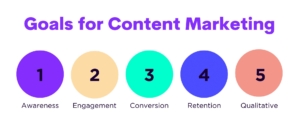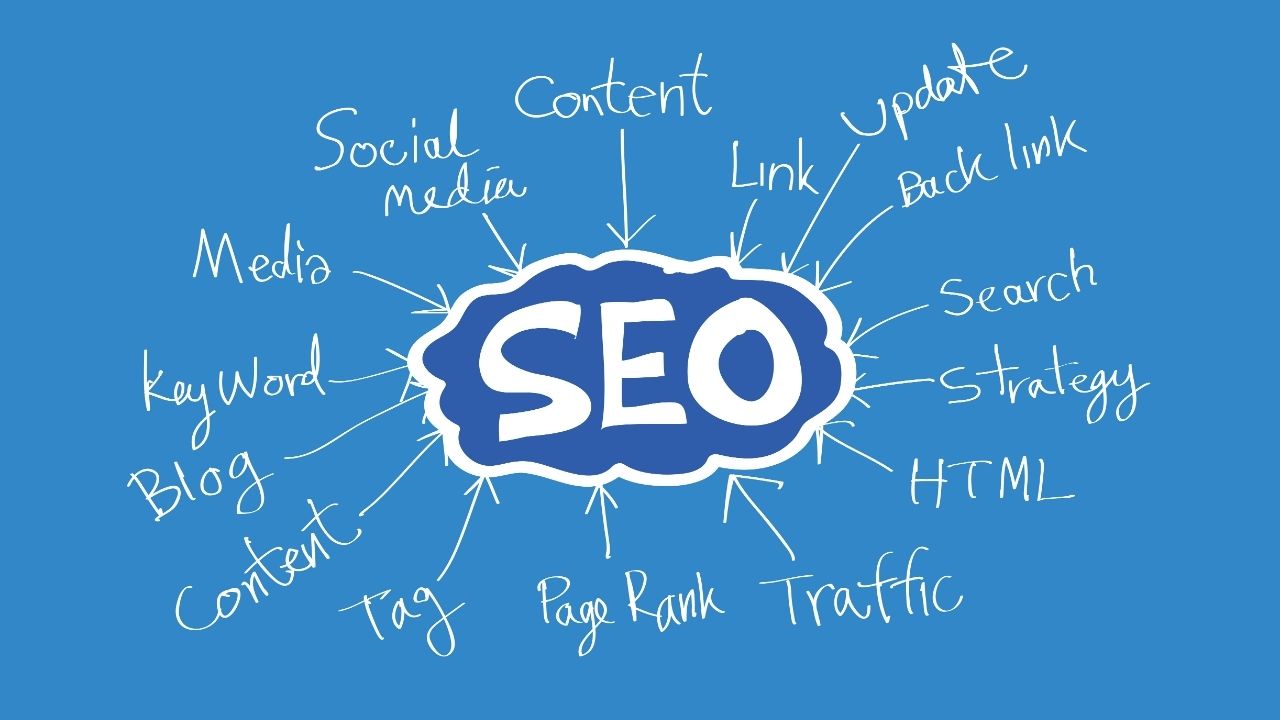𝐑𝐎𝐋𝐄 𝐎𝐅 𝐂𝐎𝐍𝐓𝐄𝐍𝐓 𝐌𝐀𝐑𝐊𝐄𝐓𝐈𝐍𝐆 𝐈𝐍 𝐒𝐄𝐎
Introduction
Content marketing involves creating and sharing valuable content to attract and engage a target audience. It’s goal is to drive profitable customer actions by addressing the audience’s needs and interests through blogs, videos, infographics, and more.
On the other hand, SEO (Search Engine Optimization) is the practice of optimizing a website to improve its visibility on search engine results pages (SERPs) through keyword research, content optimization, and building backlinks to increase organic traffic by making the site more appealing to search engines like Google, Bing, Yahoo.

How they are inter-related?
Think of SEO and Content Marketing as a power duo. Content marketing reinforces SEO. Search engine optimization improves your website ranking whereas content marketing attracts significant website traffic. They both go hand in hand to enhance a website’s overall performance.
This article explores how content marketing boosts SEO and enhances search engine rankings.
𝐖𝐡𝐚𝐭 𝐢𝐬 𝐂𝐨𝐧𝐭𝐞𝐧𝐭 𝐌𝐚𝐫𝐤𝐞𝐭𝐢𝐧𝐠?

Content marketing strategically creates and shares valuable, relevant content to engage and retain a defined audience, aiming to drive profitable customer actions by addressing specific audience needs and interests, distinct from traditional promotional tactics.
Key components of Content Marketing-
- Content Creation: Create high-quality content that is informative, entertaining or valuable to the audience.
- Content Distribution: Sharing and promoting content across channels such as social media, email newsletters, partnerships, and optimizing for search engines (SEO) where the target audience is active.
- Audience targeting: refers to Studying customer interests, demographics, and behaviors ensures that content effectively reaches its intended audience.
- Engagement and Interaction: Allowing the audience to engage and interact with the content through likes, comments and shares.
- Measurement and Analytics: Tracking and analyzing how content performs—looking at factors like website traffic, engagement levels, conversion rates, and return on investment (ROI)—helps refine strategies and meet business objectives effectively.
Types of content

- Blog posts/Articles: Drives in organic traffic by creating content that is relevant to the audience. This if the most dominant form of content on the web. People prefer detailed written and informative content.
- Social media posts: are essential for distributing content, they quickly reach targeted audiences
- Podcasts: are crucial in content distribution for their convenient, engaging format that reaches audiences during various activities.
- Infographics: are visual representations of information, data, or knowledge. They blend graphics, charts, and text into a single image to communicate complex concepts quickly and clearly.
- Videos: these are crucial in content marketing for their ability to engage viewers, convey information effectively, build emotional connections, and increase brand trust and reach,
- Email newsletter/Nurturing campaigns: They facilitate direct communication, builds relationships and drives traffic to the website.
Goals of Content Marketing
- Brand Awareness: increasing visibility and recognition of the brand among the target audience by creating quality content
- Audience engagement: creating engaging content helps fostering relationships with the audience. It aims to capture and maintain the interest of the audience, encouraging them to interact with the brand trough videos, informative articles, videos etc.
- Customer Education and engagement: providing valuable information and resources to the audience to educate them about products and services which also increases customer engagement and interaction.
- Authority Building: delivering quality content consistently establishes the brand as a trusted authority in it’s industry. The more relevant and informative the content is higher is the reach and authority.
- SEO improvement: Optimizing content for search engines helps improve visibility and organic traffic. Using relevant keywords, optimizing meta tags, and creating valuable content that attracts backlinks, content marketing contributes to higher search engine rankings and increased website traffic.
- Lead generation: content marketing helps in converting prospects into leads. By addressing the critical points and interests of potential customers through targeted content.
𝐖𝐡𝐚𝐭 𝐢𝐬 𝐒𝐄𝐎?
Search Engine Optimization is the practice of enhancing a website to improve its visibility and ranking on search engine results pages (SERPs). The primary objective is to attract more organic (unpaid) traffic from search engines like Google, Bing, and Yahoo.
Key components of SEO
- Keyword Research: finding and feeding relevant keywords to the content that potential customers use in searches.
- On-page SEO: refers to optimizing webpages and their content for both search engines and users. It can help rank pages higher on Google and drive more organic traffic.
- Off-page SEO: refers to those activities that are done outside a website to enhance it’s visibility and ranking
- Content creation: producing high-quality, relevant and engaging content that meets the needs of the customers and enhances customer retention
- Local SEO: Optimizing your online presence to attract more business from relevant local searches.
- Technical SEO: involves optimizing a website’s infrastructure to ensure it is easily crawlable, indexable, and fast-loading, improving its performance and visibility in search engine results.
Goals of SEO
- Increase organic traffic: Increase organic traffic by achieving higher search engine rankings for relevant keywords. This improved visibility attracts more interested visitors, reaching a larger audience and driving potential customers to your site.
- Improve user experience: SEO aims to enhance user experience by ensuring fast loading times, mobile-friendliness, and clear navigation. These improvements keep users engaged, reduce bounce rates, and encourage return visits.
- Enhance Content Quality: Producing high-quality, relevant content that meets audience needs and includes naturally integrated keywords. This strategy attracts and retains visitors, driving more traffic to your site.
- Increase Brand Awareness and Authority: Builds brand awareness and authority by acquiring high-quality backlinks and engaging on social media.
- Enhance local search presence: By optimizing for local queries to attract nearby customers and improve local visibility. Optimizing and maintaining your Google My Business profile is crucial for attracting local traffic and driving foot traffic to physical locations.
- Improve Conversion Rates: SEO targets users searching for your products/services, boosting conversion rates by optimizing CTAs to drive desired actions like purchases or sign-ups, thus supporting business growth.
𝐇𝐨𝐰 𝐂𝐨𝐧𝐭𝐞𝐧𝐭 𝐌𝐚𝐫𝐤𝐞𝐭𝐢𝐧𝐠 𝐞𝐧𝐡𝐚𝐧𝐜𝐞𝐬 𝐒𝐄𝐎?
- Keyword Integration: Using Targeted keywords naturally into your content helps improve search engine rankings by signaling relevance to search queries. Ensure keywords are strategically placed in titles, headers, and throughout the content to enhance visibility and attract relevant traffic.
- Content Quality: Creating high-quality, informative content is essential for attracting visitors and reducing bounce rates on your website. Such content meets user needs, provides valuable information, and encourages prolonged engagement, thereby improving overall user experience and SEO performance.
- Backlink Generation: Generating backlinks involves creating valuable content that naturally attracts links from other websites, thereby enhancing your site’s authority and credibility in search engine rankings.
- User Engagement: It indicates to search engines that the content is relevant and valuable. Creating engaging content such as interactive elements, videos, and compelling narratives can increase session durations and reduce bounce rates, contributing positively to search engine rankings.
- Fresh Content: Regularly updating content on your website signals to search engines that it’s active and relevant, improving indexing frequency. Fresh content also attracts returning visitors and encourages search engines to crawl your site more often.
- Internal Linking: Linking related content within your website to improve navigation and help users discover relevant information. This practice also distributes link equity across pages, enhancing their authority and potential to rank higher in search engine results.
𝐓𝐲𝐩𝐞𝐬 𝐨𝐟 𝐂𝐨𝐧𝐭𝐞𝐧𝐭 𝐭𝐡𝐚𝐭 𝐛𝐨𝐨𝐬𝐭𝐬 𝐒𝐄𝐎
- Blog Posts: These are in-depth articles on a specific topic. They educate, engage, and establish authority. and boost SEO by targeting keywords, improving site structure, and attracting valuable backlinks. Regular updates with quality content drive traffic, build credibility, and foster reader relationships, supporting business growth.
- Videos: Engaging visual content that can rank in search engine video sections. Videos in content marketing boost SEO by increasing engagement like time on site, diversifying content appeal, and optimizing for relevant keywords in titles and descriptions.
- Infographics: Infographics enhance SEO by attracting backlinks, optimizing keywords, and increasing engagement through visual appeal. They diversify content, cater to different learning styles, and encourage social sharing, boosting brand visibility and driving traffic.
- Case-studies: They engage audiences with real-world success stories, encouraging social shares and increasing brand visibility. Effective case studies not only drive conversions but also strengthen overall digital marketing strategies by showcasing practical solutions and measurable results.
- Social Media Posts: Provide increased audience engagement and website traffic. They attract backlinks from other websites and generate referral traffic. Sharing posts and content on social media will exposes it to a wider audience.
𝐂𝐨𝐧𝐜𝐥𝐮𝐬𝐢𝐨𝐧
Content marketing and SEO go hand in hand, making each other stronger. By combining great content with smart SEO techniques, businesses can rank higher on search engines, get more visitors, and build better connections with their audience. Using keywords, creating high-quality content, and earning backlinks all help improve SEO and lead to long-term success.
Regularly updating your website with fresh, interesting content shows search engines that your site is valuable, helping it rank higher. Using different types of content like blog posts, videos, infographics, case studies, how-to guides, and social media posts keeps your audience engaged and caters to their different preferences.
In short, the partnership between content marketing and SEO is essential for any digital marketing plan. By understanding and using this relationship, businesses can stay ahead in the online world, reach their marketing goals, and achieve steady growth.
𝐅𝐀𝐐’𝐒
1. What is content marketing, and why is it important?
– Content marketing involves creating and sharing valuable, relevant content to attract and engage a specific audience. It’s crucial because it helps businesses build brand authority, nurture relationships with customers, and drive profitable actions.
2. How does content marketing help in building brand awareness?
– By consistently producing informative and entertaining content, businesses can increase their visibility online. This content educates potential customers about their products or services, ultimately building brand recognition and trust.
3. Can content marketing help in generating leads and conversions?
– Absolutely. Content marketing nurtures leads by providing them with valuable information throughout their buying journey. By demonstrating expertise and addressing customer concerns, businesses can convert leads into customers more effectively.
4. How does content marketing impact SEO (Search Engine Optimization)?
– Quality content is a critical factor in SEO. Search engines prioritize websites that regularly produce high-quality, relevant content. By optimizing content with targeted keywords, businesses can improve their search engine rankings and attract more organic traffic.
5. Is content marketing suitable for all businesses, regardless of size?
– Yes, content marketing is adaptable to businesses of all sizes and industries. Small businesses can use it to establish authority and compete with larger competitors, while large businesses can maintain customer engagement and loyalty.
6. How important is consistency in content creation and publishing?
– Consistency is key to maintaining audience interest and search engine visibility. Regularly publishing high-quality content keeps the brand top-of-mind and signals search engines that the website is active and relevant.







